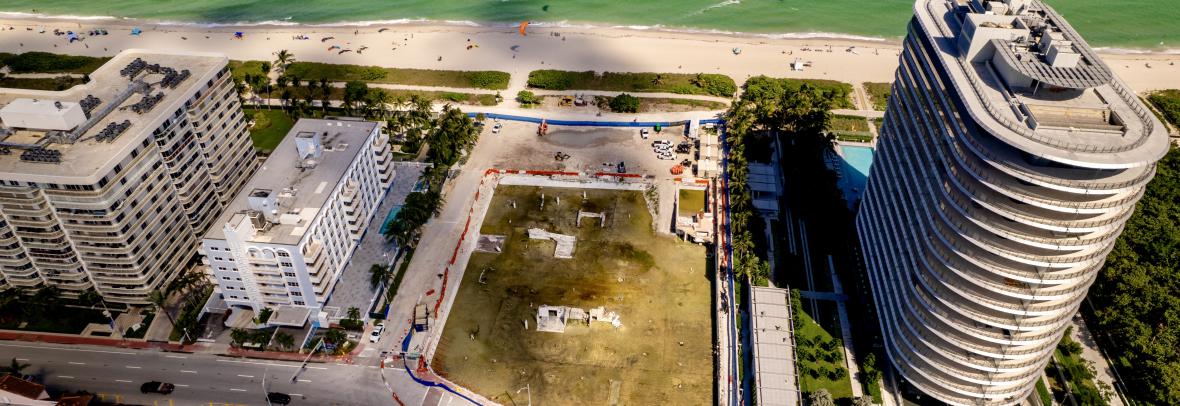
Pool Deck Likely Origin of Surfside Condo Collapse
Federal investigators analyzing the 2021 Surfside condo collapse said they think there is conclusive evidence that a pool deck collapsed before the tower. A final report won't be ready until 2025.
FORT LAUDERDALE, Fla. – A federal probe into the June 2021 collapse of a Surfside condo tower that left 98 people dead continues to point to the building’s pool deck as the most likely initiation point of the collapse, investigators said Thursday at a meeting in Maryland.
In their first public update since last fall on a years-long effort to determine what caused the tragedy, investigators for the National Institute of Standards and Technology presented a detailed look at how they are analyzing video footage and eyewitness interviews to inch closer to a conclusion.
Investigators said there is “strong evidence” that the collapse began in the pool deck of the 12-story, L-shaped Champlain Towers South building, though they have not yet ruled out an initial failure point “in some part of the tower” that could have led to the collapse of the pool deck.
“We have very, we think, conclusive evidence now that the pool deck collapsed before the tower,” said Glenn Bell, team associate leader for the investigation. “What we are still analyzing is what the initiating events were.”
Nearly $30 million has been spent on the probe since it began in 2021, investigators said Thursday. In addition to testing materials from the collapse site and building complex computer models, investigators have been interviewing survivors and other eyewitnesses with help from a team at Florida International University.
They have also been analyzing several videos to better understand the collapse sequence, including a video taken by a tourist the night of the collapse that showed water gushing into the garage and chunks of concrete covering the floor on the north side of the building.
Investigators said they worked with the FBI to enhance the video, which helps prove that the pool deck collapsed into the parking garage before the east portion of the tower collapsed.
A draft report of the investigation is still more than a year away, anticipated in May 2025. A final report is expected in September 2025 and will have implications for millions of high-rise dwellers around the world, with recommendations on changes to building codes and construction practices that could prevent a similar catastrophe from happening elsewhere.
“We want our investigation of this failure to have lasting impact,” said Judith Mitrani-Reiser, the lead investigator on the NIST investigation and a Miami native. “We want it to save lives, and we want it to ensure this never happens again.”
The findings so far echo a Miami Herald investigation, which found that the pool deck collapsed several minutes before half of the tower fell. In consultation with structural engineers, the Herald identified major weaknesses in the structure and other problems that compounded in the weeks before the collapse. Those included areas where the pool deck appeared to be sagging dangerously, cracking a nearby planter.
Investigators said that among the “most probable” initiation points were failures in slab-column connections in the pool deck that caused the slab around the columns to drop. “Knocking noises” heard by some residents before the collapse bolster the notion that steel reinforcements had fractured at those connection points.
In a presentation last June, investigators said the 40-year-old building’s pool deck had “critically low margins against failure” because of pervasive weaknesses in the structural design that were exacerbated by misplacement and corrosion of the reinforcing steel within the deck, as well as the addition of planters and heavy pavers that were not accounted for in the original designs.
While the team of dozens of engineers and other experts is considering about two dozen failure hypotheses, it is seeking to rule out possibilities that appear less likely.
That includes underground factors like a sinkhole in the limestone underneath the tower or uneven settlement of the building’s foundation. Investigators said Thursday there is “very low probability” that those factors contributed to the collapse.
The probe has found no evidence of an explosion or other extraordinary event that could have triggered the incident.
Investigators have yet to elaborate on how the pool deck collapse would have caused the tower to fall minutes later. But computer simulations performed by researchers at the University of Washington in collaboration with the Herald showed that when the deck fell and disconnected from a perimeter wall at the south end of the pool, damage would have spread into the tower along the ground floor near the gym at the center of the L-shaped structure.
Experts who consulted on the Herald’s forensic investigation said the preliminary deck collapse would have strained the columns along half of the tower’s perimeter, causing them to fracture and ultimately collapse inward along with the majority of the tower.
© 2024 Miami Herald. Distributed by Tribune Content Agency, LLC.
